Are you considering getting a cute, tiny pet as your companion? Then, having a turtle is one of the best options you can go with. Turtles are fascinating reptiles with a long history, dating back millions of years. So, among these ancient creatures, what turtles stay small? Many turtle species are really small are they don’t grow big even if they are adults. The smaller your pet, the easier it is to handle it for most of the time.
These little guys are perfect for those who love turtles but might not have a lot of space. A small turtle can also be easier to set up and take care of, so they’re a good choice for first-time owners. In today’s post, we will explore what makes turtles stay small. We will cover, from mud turtles to red-eared sliders and details about them.
Why Choose a Small Turtle?
Turtles come in all sizes, just like our furry friends. But if you live in an apartment or just don’t have a ton of space, a small turtle might be the most suitable pet for you. Here’s why:
- Less Room Needed: Small turtles don’t need a giant mansion (well, we are talking about a giant tank mansion). Their small size means they can live comfortably in a tank that won’t take up your whole living room.
- Less Cleaning, More Fun: Generally, smaller turtle tanks require simpler setups. This means less water to change and less space to scrub. Cleanup is easy with a smaller tank, so you can spend more time playing with your tiny shelled friend.
What Turtles Stay Small: 9 Small Species
Here we listed 9 most small turtle species and their length ranges from 2-7 inches. Many turtles are said to be small and can reach up to 12 inches or more. So, let’s look at the tiny and cute turtle species
1. Reeve’s Turtle: The Smiling Charmer
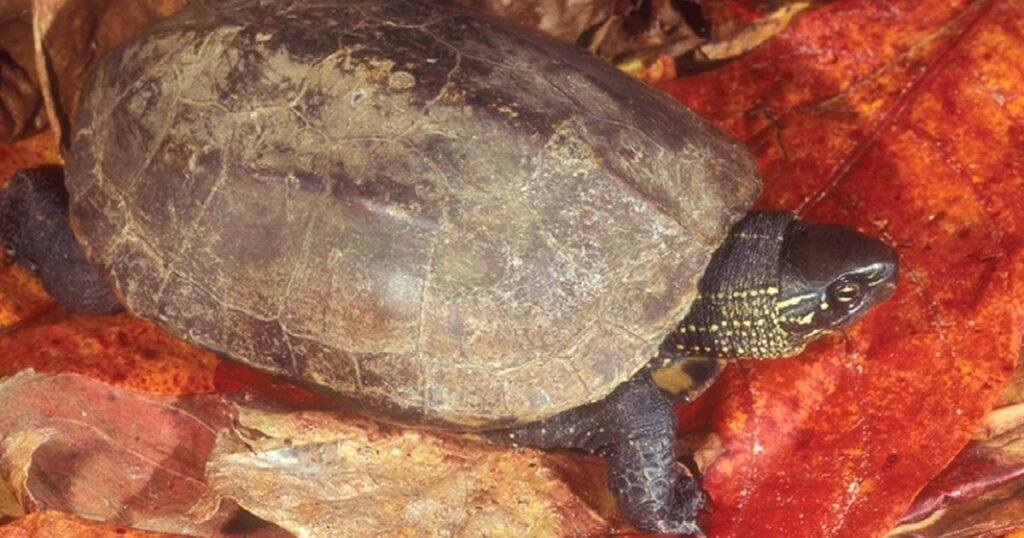
Scientific Name: Mauremys reevesii
Lifespan: Around 20 years
The Reeve’s turtle, also known as the Chinese pond turtle, might not have the most colorful shell. But they are loved for their adorable personalities. They’re small turtles that reach only 4-6 inches in shell length.
Appearance:
- Mostly olive green or black shell with three distinct ridges.
- Unique facial markings that resemble a smile.
Personality:
- Energetic swimmers who enjoy exploring their environment.
- Generally docile and considered easy to care for.
Care Requirements:
- Tank: At least 25-30 gallons with a basking area.
- Temperature: Water temperature around 80°F, basking area around 100°F with UVB light.
- Diet: Omnivorous, including insects, fish, aquatic plants, and some fruits.
- Water: Keep the water clean with a high-quality filter as Reeve’s turtles can be messy eaters.
Things to Know:
- Not very social, so they should be kept alone.
- Prone to shell diseases, so watch for any abnormalities.
- Can live up to 20 years with proper care.
If you can provide a clean, stimulating environment and a varied diet, the Reeve’s turtle can be a rewarding pet. They’re a favorite among turtle lovers because of their charming smile and playful personality.
2. Diamondback Terrapin (Size 3-5 inches)
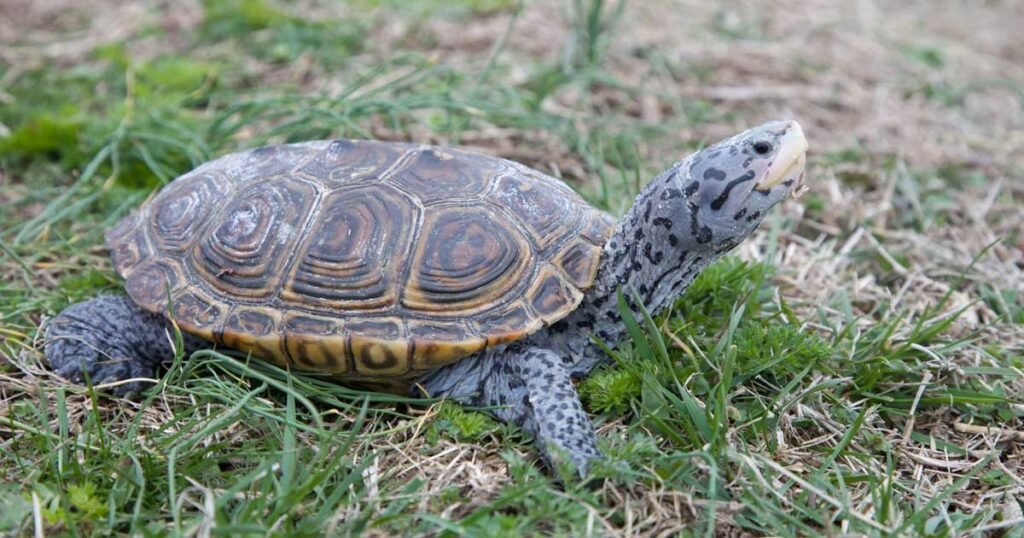
Scientific Name: Malaclemys terrapin
Lifespan: Around 40 years
The Diamondback Terrapin is named for the unique diamond shapes on its shell. It is a fascinating semi-aquatic turtle native to the Atlantic and Gulf coasts of the United States. Males typically grow between 3 and 5 inches long, while females can reach 4 to 7 inches. These hardy turtles are known for their calm personalities and interesting adaptations to brackish water environments.
Appearance:
- Diamond-shaped patterns on their shells in various colors, unique to each turtle.
- Gray or brown shells with striped skin.
- Large, webbed feet for powerful swimming.
Personality:
- Generally docile and easy to care for.
- Active swimmers who enjoy exploring their environment.
Care Requirements:
- Tank: Large tank (80-100 gallons) with a mix of saltwater and freshwater areas.
- Basking area: Provide a dry land area for basking and resting.
- Diet: Omnivorous, including fish, insects, aquatic plants, and small invertebrates.
- Lighting: Heat lamp and UVB light to regulate temperature and promote healthy growth.
Things to Know:
- Diamondback terrapin populations are threatened in some areas. Check local laws before acquiring one as a pet.
- They can live up to 40 years with proper care.
The Diamondback Terrapin is one of the most captivating turtles to have in your home aquarium, but you need to be experienced with them. They need a large setup that mimics their natural habitat for their brackish water habitat.
3. Mississippi Mud Turtles (Size: 3-5 inches long)
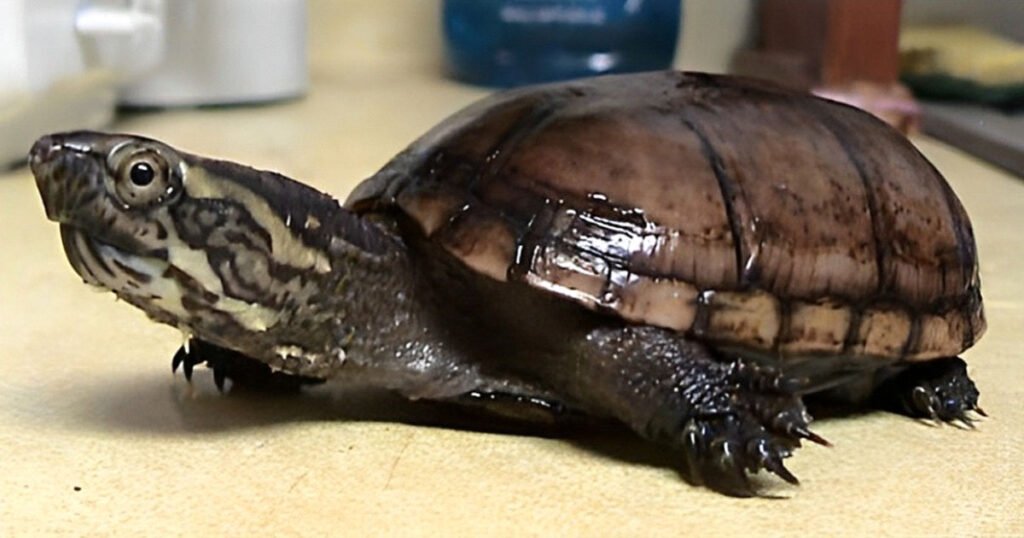
Scientific Name: Kinosternon subforum hippocrepis
Lifespan: Around 50 years
The Mississippi Mud Turtles also known as eastern mud turtles are tiny semi-aquatic little turtles. They are found in the eastern United States, in places with fresh water like ponds, marshes, and slow-moving streams. These tiny turtles are good at hiding because their shells are smooth and round, and their color can be brown or gray to match the mud and plants around them. This makes it very difficult for other animals to see them.
Appearance:
- Shell (carapace): Smooth, rounded, and varies in color from light brown to dark gray depending on the region.
- Size: Compact, with a length of within 3-5 inches.
- Other features: No distinct markings or patterns on the shell.
Personality:
- Generally docile and calm
- Curious and enjoy exploring their environment at their own pace, but not the strongest swimmers.
Care Requirements:
- Habitat: A 40-gallon tank with a mix of water and land area. Mud turtles need a basking platform for resting and drying out since they’re not strong swimmers.
- Diet: Omnivorous, including aquatic plants, insects, fish, and occasional fruits. You can also offer commercial turtle pellets as a supplement to their diet.
- Water: Keep the water clean and provide a basking area with a heat lamp and UVB light to regulate temperature and promote healthy shell growth.
Things to Know:
- Mud turtles are relatively easy to care for, making them a good choice for beginner turtle owners.
- With proper care, they can live up to 50 years.
- It’s important to check local laws before getting a mud turtle as a pet, as they’re endangered in some areas.
The Mississippi mud turtle can be a fascinating companion for those who keep it clean and stimulating. Their small size, adaptable nature, and calm personalities make them a great choice for turtle lovers.
4. Common Musk Turtle (Size: 3-5 inches long)
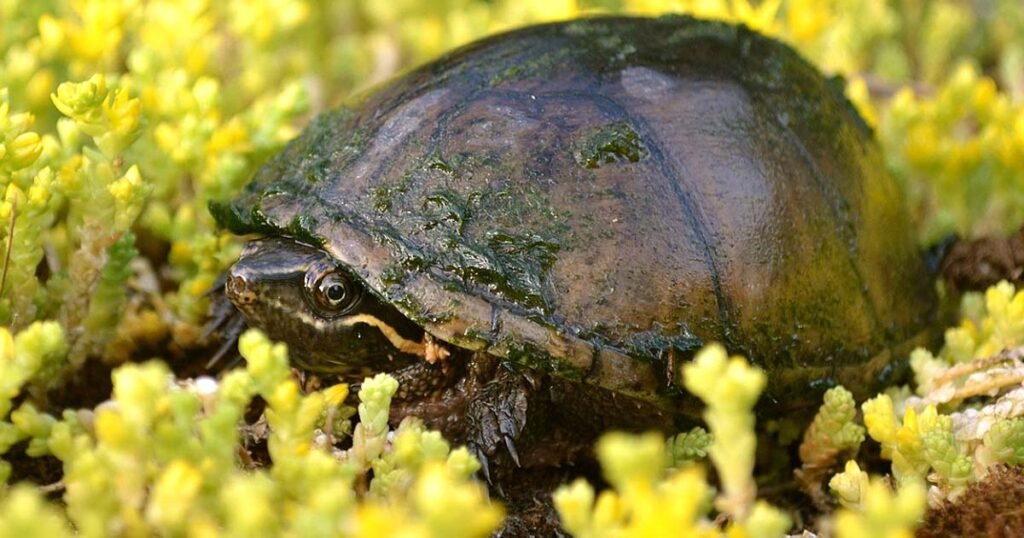
Scientific Name: Sternotherus odoratus
Lifespan: Around 50 years
The Musk Turtle is a tiny turtle that lives in the eastern United States and parts of southern Canada and Mexico. They prefer shallow, slow-moving waters with lots of plants. Unlike some turtles, they don’t spend much time basking in the water.
Appearance:
- Dark gray or almost black shell, sometimes with a greenish tinge.
- Two yellow stripes on the head.
- Small and round shell compared to other turtles.
Personality:
- Generally calm and easy to care for.
- Can be shy and may release a musky odor if scared.
- Good swimmers but prefer to stay on the bottom of the water.
Care Requirements:
- Tank: A 30-gallon tank is enough for one Musk Turtle.
- Land area: They need a place to rest and climb out of the water.
- Water filter: Keep the water clean.
- Food: They eat a variety of things like insects, small fish, and small shrimp.
Things to Know:
- They are a good choice for beginner pet owners because they are small and easy to care for.
- Be sure to check your local laws before getting a Musk Turtle, as they may be endangered in some areas.
- Musk Turtles can release a strong-smelling musk when threatened, a clever way to deter predators. For this nature, they are also known as stinkpot turtles.
- Their lower shell (plastron) has a hinge, allowing them to completely close up for extra protection.
These fascinating little turtles can be rewarding companions for those who can provide a clean and stimulating aquatic environment.
5. Eastern Box Turtle (Size: 4-6 inches)
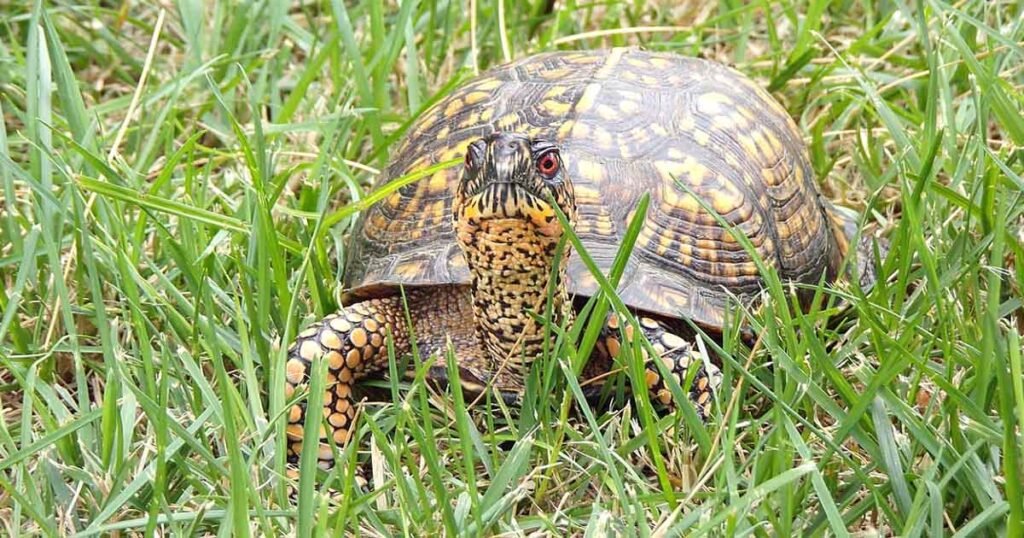
Scientific Name: Terrapene Carolina Carolina
Lifespan: Around 50 years
Eastern box turtles can be found throughout the eastern and southern United States. They’ve even ventured to Mexico. They’re 4 to 6 inches long and live in forests, fields, marshes, and even backyards. While Eastern Box Turtles can be captivating creatures, they are not recommended as they are wild animals.
Appearance:
- Dark brown or black carapace (upper shell) with vibrant yellow or orange spots in unique patterns.
- Colors may fade with age.
- Males have red eyes, while females have brown eyes.
- The S-shaped neck allows them to tuck their heads inside the shell.
Personality:
- Shy and solitary creatures, preferring to stay hidden.
Care Requirements:
- 20-gallon tank (upgrade to 60-100 gallons for adults)
- Land area with branches and hiding spots
- Water dish with ramp
- Heat source and UV light
- Vegetables, insects, occasional fish/shrimp
Things to Know:
- Eastern Box Turtles are classified as vulnerable due to habitat loss and road mortality.
- Considered high-maintenance pets due to their specific habitat needs, both indoors and outdoors.
- Eastern Box Turtles are carriers of salmonella, so proper hygiene is essential when handling them.
- Live in forests, fields, meadows, and even backyards.
- Increased risk of car accidents due to venturing into human settlements.
While Eastern Box Turtles can be captivating creatures, it’s important to remember that they are wild animals. They’re not recommended as pets for several reasons. They have specific habitat needs, like a balance between land and water. They’re also shy and can get stressed in a human environment. If you encounter them in the wild, admire them from a distance and avoid disturbing them.
6. Spotted Turtle (Size: 3-5 inches)
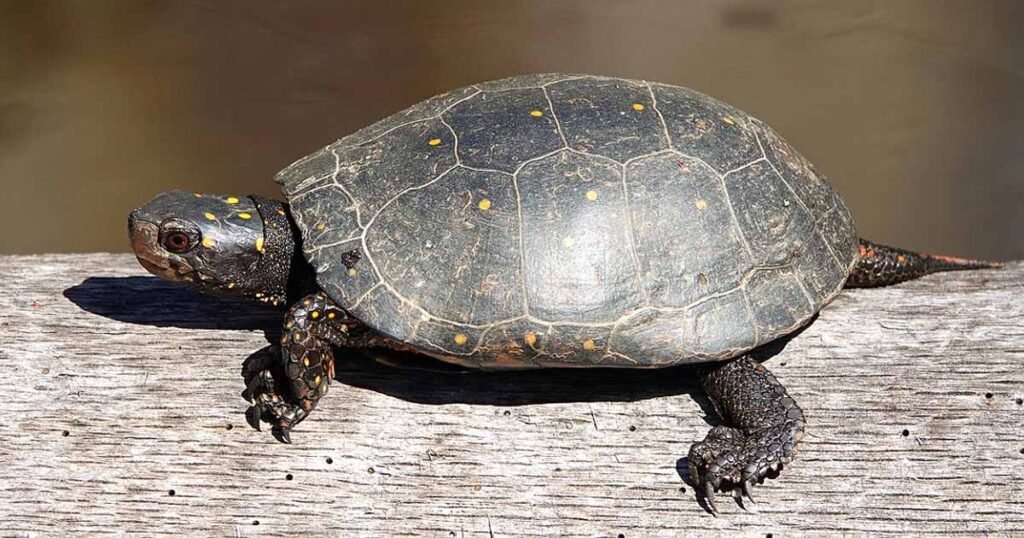
Scientific Name: Clemmys guttata
Lifespan: Over 100 years
Spotted Turtles are tiny turtles found in eastern North America with yellow spots on their dark shells. These little charmers prefer shallow, weedy wetlands where they can bask in the sun, hunt for food, and hide among the vegetation.
Appearance:
- Dark brown or black carapace (upper shell) adorned with bright yellow spots in a unique pattern for each turtle.
- No fancy stripes or markings on their otherwise smooth shell.
- Small head with dark patches.
Personality:
- Generally shy and peaceful.
- Quite active when searching for food.
Care Requirements:
- Enclosure: shallow water area (avoid deep water) as they are not good swimmer.
- Land Area: Equal amount of space as water with hiding spots
- Heat source: Yes
- UV Light: Yes
- Food: Vegetables, insects, occasional meat or fish
Things to Know:
- Spotted turtles are one of the tiniest turtle species in North America.
- Sadly, they are listed as an endangered species due to habitat loss.
- These turtles are carnivores and enjoy a diet of insects, worms, and small fish.
- They are not strong swimmers and prefer to stay in the shallows where they can walk on the bottom.
Even though Spotted Turtles are fascinating creatures, it’s important to remember they are threatened. These curious and active turtles can become easily stressed if overhandled. Seeing them in the wild is a true treat, but keeping them as pets is not recommended.
7. Bog Turtle (Size 3-4.5 inches)
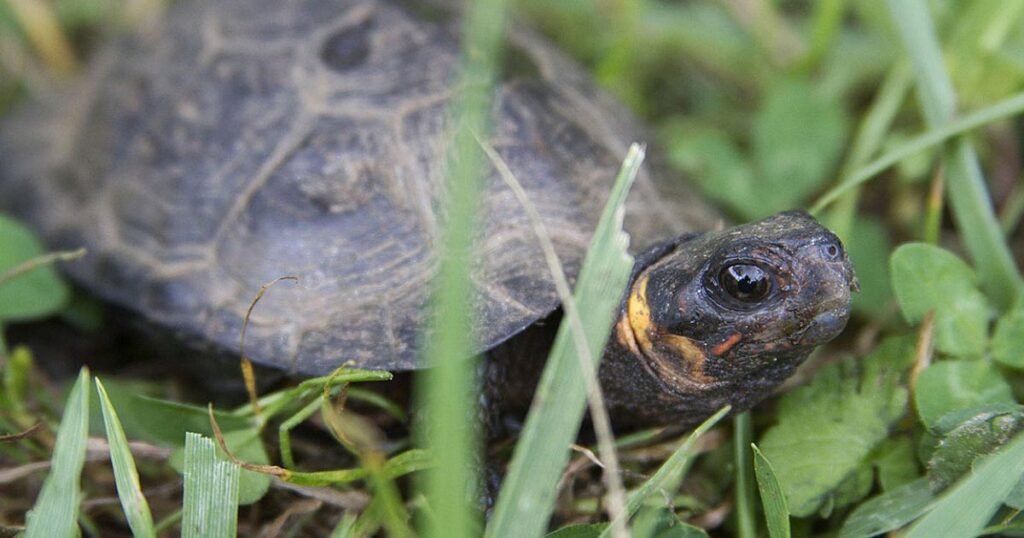
Scientific Name: Glyptemys muhlenbergii
Lifespan: Around 60 years
The bog turtle is a tiny species of the turtle world. It’s one of the smallest turtles in North America and their size is only 3-4.5 inches long. They have adorable unique markings and tiny structures. Sadly, bog turtle species are endangered in the turtle world.
Appearance:
- Dark brown shell with no hinge
- Bright orange patch on each side of the head (unique feature)
- Males have thicker and longer tails than females
Personality:
Bog turtles are wild animals and their personalities are not widely observed. They like to live in hiding places (plants, mud, etc) in the wild.
Care Requirements:
(However, they are not recommended as pets due to their endangered status and specific habitat needs)
- Shallow water area
- 2×3 foot enclosure (more space for multiple turtles)
- Terrestrial area with hiding spaces
- UVB light bulb
- Heater
- Water Filter System
- Feed adult bog turtles three to four times a week including – worms, snails, aquatic plants, berries, occasional fruits, and beetles.
Things to Know:
- Endangered Species: Keeping them as pets harms the population.
- Habitat Needs: Difficult to replicate in captivity (shallow water & land space).
- Delicate Creatures: Can become easily stressed.
Observe them in the wild (with proper research and guidance) or support conservation efforts.
8. Razorback Musk Turtle (Size 5-6 inches)
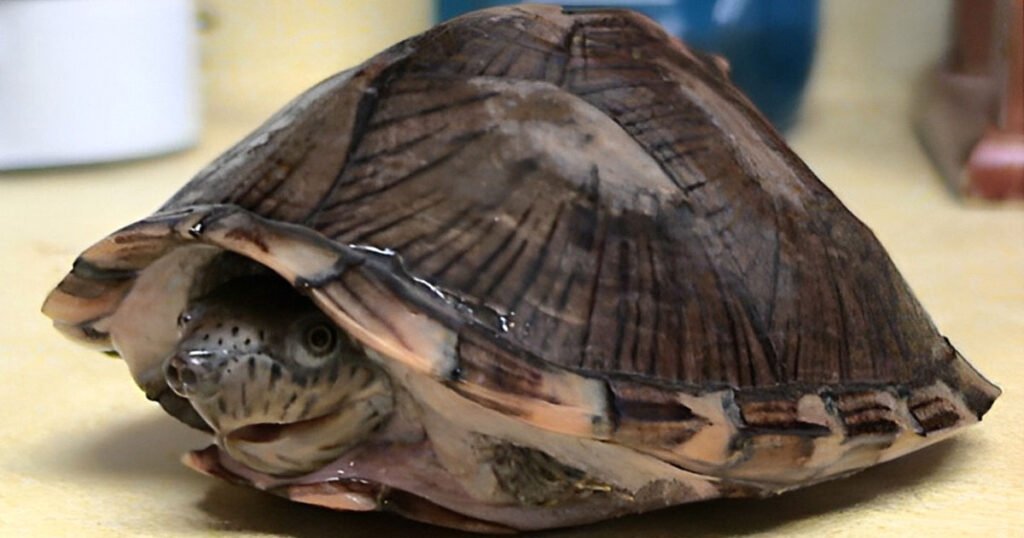
Scientific Name: Sternotherus carinatus
Lifespan: around 20-15 years
The Razorback Musk Turtle belongs to the Kinosternidae family and is smaller in size. The name of this turtle comes from its distinctive sharp keel (ridge) running down its back.
Appearance:
- Brown-colored shell with black markings on each scute
- Bulbous head with a sharp beak and long neck
- Greyish-brown body with black spots
- Short legs and a small plastron with only one hinge
- Males have longer tails than females
Personality: shy and quiet
Care Requirements:
Razorback Musk Turtles are said to be a good pet for beginners because they are easy to maintain.
- Pet Difficulty: Beginner (if legally obtainable)
- Diet: Omnivorous (insects, crayfish, snails, fish, amphibians, aquatic plants, seeds).
- Habitat: 50-gallon tank with shallow water area and basking platform (not recommended for pets).
Things to Know:
- Native to the southern United States (Alabama, Arkansas, Louisiana, Mississippi, Oklahoma, Florida, and Texas).
- Primarily aquatic, found in slow-moving waters like creeks, ponds, and swamps
- Long lifespan: 20-25 years
If you are planning to have a tiny pet turtle then a razorback musk turtle can be a good choice.
9. The Speckled Padloper Tortoise (Size 2-3 inches)
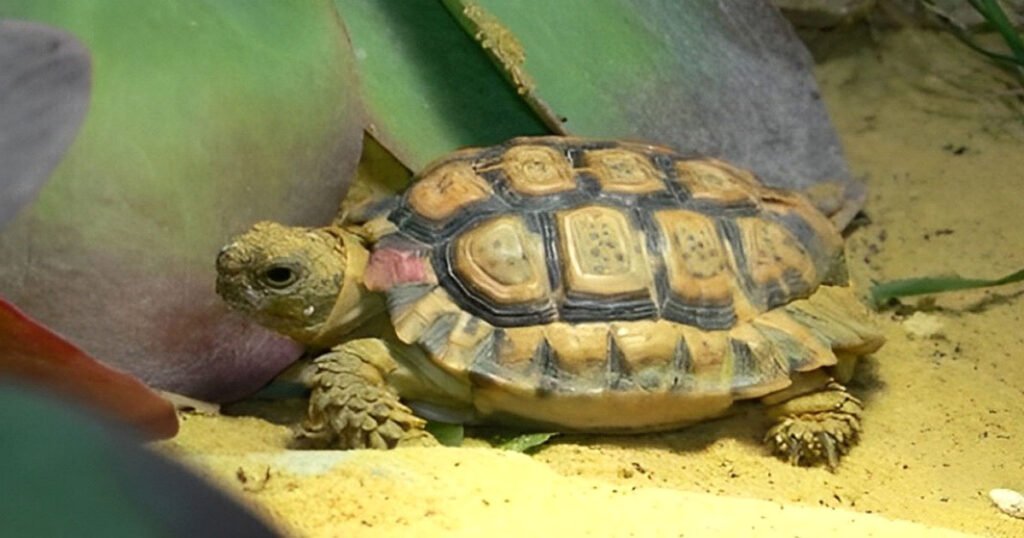
Scientific Name: Chersobius Signatus
Lifespan: around 50 years
In the turtle world, the Speckled Padloper is the smallest turtle, specifically a tortoise. They belong to the family Testudinidae.
Appearance:
- Unique shell with pronounced scutes, resembling a miniature pyramid formation.
- Rough-looking scales on their legs.
- Overall appearance compared to dinosaurs due to their textured features.
Personality: Not applicable to wild animals.
Care Requirements:
Because of their specific needs and endangered status, they’re not recommended as pets. It can be hard to breed them in captivity.
Diet (Wild): Small, succulent plants found between rocks in their natural habitat.
Habitat (Wild): Rocky outcrops in Little Namaqualand, South Africa.
Things to Know:
- Originally classified into two subspecies, but genetic studies have shown them to be a single species.
- Males are slightly smaller than females, reaching a maximum of 3.9 inches.
- Their flattened shell has an orange-brown base adorned with black spots.
- They have five toes on their front feet, unlike some relatives who only have four.
- Most active during early mornings, especially during breeding seasons (autumn and spring).
- Mating behavior involves a head-nodding ritual between males and females.
- Females lay eggs in damp soil nestled among rocks.
- Hatchlings are incredibly small, weighing less than 7 grams and measuring only 1.2 inches.
- Eggs take approximately 100-120 days to hatch.
- Females lay up to 5 eggs per year.
The Speckled Padloper Tortoise is an endangered species. To appreciate these tiny titans, we must support conservation efforts to protect their habitat.
FAQs
What type of turtles stay small?
Some turtle species are naturally small, but even these guys can live for decades (20-50 years!). Before getting a tiny friend, consider their needs:
- Space: Small turtles still need room to roam, bask, and swim (if aquatic).
- Care: Different species have specific diets and habitat needs. Research is key!
Tiny Turtle Options:
- Razor-backed Musk Turtle: Grows to 5.9 inches, known for easier care.
- Spotted Musk Turtle: Reaches 4.5 inches, and prefers shallow water.
- Bog Turtle: Stays small (4-5 inches) and lives on land.
What aquatic turtles stay small?
Some aquatic turtles stay small: Musk Turtles (friendly & colorful), Spotted Turtles (easy to care for), and Mud Turtles (curious explorers). It is important to remember that even small turtles require good care. Research their needs and consider setting up a recommended tank environment.
What turtles stay small forever?
No turtles truly stay “small forever.” Small species can live for decades and grow to a certain size. However, some aquatic turtles stay on the smaller side and can thrive in tanks. These turtles include Musk Turtles, Spotted Turtles, and Mud Turtles
What breed of turtles stay small?
Some turtles like Diamondback terrapin, Reeve’s turtle, Musk, Spotted, or Mud varieties stay small and do well in tanks under 100 gallons. Turtles, even small ones, need a long and healthy life. Research their needs before getting one.
Read More: 8 Best Types Of Pet Turtles
Wrapping Up
Finding “What turtles stay small?” can be tricky if you are new. But with a little research, you can find the perfect match for your under-100-gallon tank. Remember, these little guys might be compact, but they still have big needs! Before you bring your new shelled friend home, make sure they have a happy and healthy place to live. Happy turtling!
